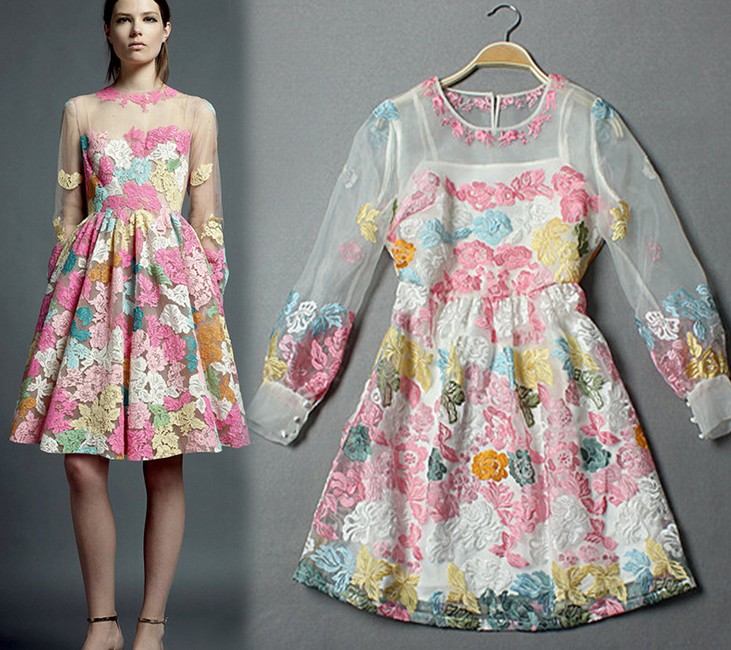Silk Dresses Online Biography
Source(google.com.pk)
History:
The production of silk originates in China in prehistoric times, as early as in the Neolithic (Yangshao culture, 4th millennium BCE). Silk remained confined to China until the Silk Road opened at some point during the later half of the first millennium BCE. China maintained its virtual monopoly over silk production for another thousand years. Not confined to clothing, silk was also used for a number of other applications, including writing, and the color of silk worn was an important indicator of social class during the Tang Dynasty.
Silk cultivation spread to Japan around 300 CE, and, by 522 CE, the Byzantines managed to obtain silkworm eggs and were able to begin silkworm cultivation. The Arabs also began to manufacture silk during this same time. As a result of the spread of sericulture, Chinese silk exports became less important, although they still maintained dominance over the luxury silk market. The Crusades brought silk production to Western Europe, in particular to many Italian states, which saw an economic boom exporting silk to the rest of Europe. Changes in manufacturing techniques also began to take place during the Middle Ages, with devices such as the spinning wheel first appearing. During the 16th century France joined Italy in developing a successful silk trade, though the efforts of most other nations to develop a silk industry of their own were unsuccessful.
The Industrial Revolution changed much of Europe’s silk industry. Due to innovations in spinning cotton, cotton became much cheaper to manufacture and therefore caused more expensive silk production to become less mainstream. New weaving technologies, however, increased the efficiency of production. Among these was the Jacquard loom, developed for silk embroidery. An epidemic of several silkworm diseases caused production to fall, especially in France, where the industry never recovered. In the 20th century Japan and China regained their earlier role in silk production, and China is now once again the world’s largest producer of silk. The rise of new fabrics such as nylon reduced the prevalence of silk throughout the world, and silk is now once again a rare luxury good, much less important than in its heyday.
Early History:
The earliest evidence of silk was found at the sites of Yangshao culture in Xia County, Shanxi, where a silk cocoon was found cut in half by a sharp knife, dating back to between 4000 and 3000 BCE. The species was identified as Bombyx mori, the domesticated silkworm. Fragments of primitive loom can also be seen from the sites of Hemudu culture in Yuyao, Zhejiang, dated to about 4000 BCE. An ivory basin incised with silk worm designs was found in a Hemudu site in Zhejiang and is datable to around 4900 BC. The earliest example of silk fabric is from 3630 BC, and was used as wrapping for the body of a child. The fabric comes from a Yangshao site in Qingtaicun at Rongyang, Henan. Scraps of silk were found in a Liangzhu culture site at Qianshanyang in Huzhou, Zhejiang, dating back to 2700 BCE. Other fragments have been recovered from royal tombs in the Shang Dynasty (c. 1600 – c. 1046 BCE).
During the later epoch, the Chinese lost their secret to the Koreans, the Japanese, and, later, the Indians, as these cultures discovered how to make silk. Allusions to the fabric in the Old Testament show that it was known in western Asia in biblical times.[5] Scholars believe that starting in the 2nd century BCE the Chinese established a commercial network aimed at exporting silk to the West.[5] Silk was used, for example, by the Persian court and its king, Darius III, when Alexander the Great conquered the empire. Even though silk spread rapidly across Eurasia, with the possible exception of Japan its production remained exclusively Chinese for three millennia.
Myths and legends:
The writings of Confucius and Chinese tradition recount that, in the 27th century BCE, a silk worm's cocoon fell into the tea cup of the empress Leizu. Wishing to extract it from her drink, the 14-year-old girl began to unroll the thread of the cocoon.
She then had the idea to weave it. Having observed the life of the silk worm on the recommendation of her husband, the Yellow Emperor, she began to instruct her entourage in the art of raising silk worms, sericulture. From this point, the girl became the goddess of silk in Chinese mythology. Silk eventually left China via the heir of a princess who was promised to a prince of Khotan. This probably occurred in the early 1st century CE. The princess, refusing to go without the fabric that she loved, would finally break the imperial ban on silk-worm exportation.
Though silk was exported to foreign countries in great amounts, sericulture remained a secret that the Chinese carefully guarded. Consequently, other peoples invented wildly varying accounts of the source of the incredible fabric.
In classical antiquity, most Romans, great admirers of the cloth, were convinced that the Chinese took the fabric from tree leaves.[8] This belief was affirmed by Seneca the Younger in his Phaedra and by Virgil in his Georgics. Notably, Pliny the Elder knew better. Speaking of the bombyx or silk moth, he wrote in his Natural History "They weave webs, like spiders, that become a luxurious clothing material for women, called silk."









No comments:
Post a Comment